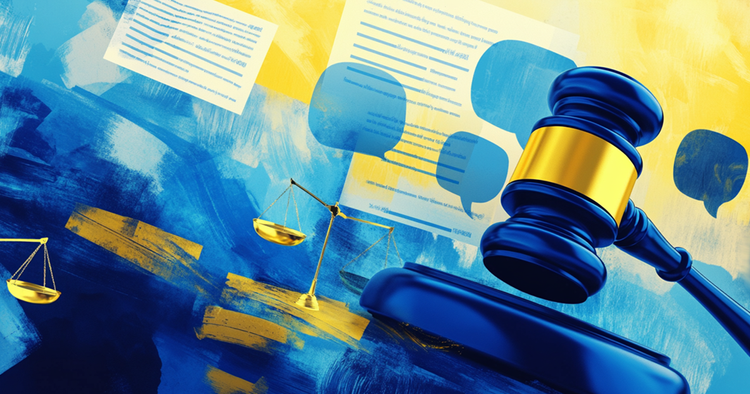AI in Legal Transcription: How It Works and Why Prevail Does It Better

Court reporters play an indispensable role in legal proceedings, but they are in short supply, and the legal system is feeling the strain. A well-documented court reporter shortage in California has left over a million hearings without a verbatim record since January 2023. The demand for accurate, timely transcription has never been higher, but the workforce alone can’t keep up.
That’s where legal technology is filling the gap, but the solutions are not without controversy. AI-powered transcription, for example, sparks strong opinions ranging from excitement to skepticism. Can it match the precision of a professional legal transcriptionist? Will it introduce errors that jeopardize a case? Some fear AI is an all-or-nothing replacement, but that’s not the whole picture.
When applied thoughtfully, AI can support human expertise rather than replace it. And for legal professionals drowning in delays, that distinction matters. Understanding how AI fits into legal transcription helps break through the buzzwords and clarify what this technology actually is—and what it isn’t.
Understanding AI in Context
AI is a broad term that gets thrown around a lot, often without much clarity. It’s easy to picture AI as some kind of omniscient machine, but in reality, it’s more like a collection of specialized tools working together. Let's break it down to see where AI fits into legal transcription.
The AI Hierarchy
At its core, AI encompasses a spectrum of technologies designed to perform tasks that typically require human intelligence. Within this realm lies Natural Language Processing (NLP), a technology focused on the interaction between computers and human language. NLP enables machines to process, interpret, and generate human language, enabling communication between person and machine.
Delving deeper, we encounter Automatic Speech Recognition (ASR), a specialized application of NLP. ASR transcribes spoken language into written text, a cornerstone in transcription services. Its development spans decades, evolving from rudimentary systems to sophisticated models capable of handling diverse accents and dialects.
Generative AI, another facet of this hierarchy, has transformed from its early days of conceptualizing Natural Language Generation (NLG) in the 1960s to today's advanced models and applications. Initially, NLG systems, like ELIZA in the mid-1960s, utilized simple pattern-matching and rule-based approaches to mimic human conversation. Over time, these systems evolved, incorporating complex algorithms to generate human-like text, thereby enhancing AI's capabilities in understanding and producing language.
Key Technologies in Transcription
The backbone of AI-driven transcription lies in ASR, which has seen significant advancements in recent years. Modern ASR systems leverage deep learning-based acoustic models to convert speech into text with high accuracy. These models are trained on vast datasets, enabling them to recognize and transcribe speech across different languages, accents, and contexts. Continuous improvements in neural networks and language modeling techniques have further enhanced ASR’s ability to capture nuances in spoken language, making transcription more precise and reliable than ever.
Machine learning plays a central role in transcription, particularly through ASR models trained on extensive speech corpora to convert spoken language into text. After transcription, large language models (LLMs) enhance accuracy by applying context, semantics, and linguistic nuances, especially when dealing with complex terminologies, such as in legal contexts.
However, the journey doesn't end with transcription. NLP further processes the transcribed text, ensuring it aligns with grammatical standards and accurately reflects the intended meaning, a crucial step in legal settings.
As AI continues to evolve, its integration with transcription services offers a promising solution to the challenges posed by human resource shortages in the legal industry. Yet, misconceptions about AI's role and reliability persist, often clouding its potential benefits.
Common AI Misconceptions
AI in transcription sparks plenty of debate, but much of the skepticism comes from misunderstanding how the technology actually works. Let’s clear up a few of the biggest misconceptions.
AI Isn’t a Replacement—It’s a Tool
One of the most persistent fears is that AI is here to replace court reporters and human transcriptionists entirely. That’s not the case. AI transcription is an enhancement, not a substitute. When used effectively, it helps legal professionals work more efficiently—not by removing human expertise, but by supporting it.
Think of AI as an assistant that speeds up routine tasks, like converting audio into searchable text. By automating the time-consuming parts of transcription, AI-driven tools can improve turnaround times for certified transcripts, ensuring that case materials are available when attorneys and judges need them most.
In an industry where backlogs can delay cases for weeks—or longer—leveraging AI doesn’t mean cutting corners. It means making better use of valuable resources.
What About Accuracy?
Reservations about AI’s accuracy are valid, but it’s important to separate fact from fiction. Not all AI transcription models are created equal, and the technology has come a long way, especially in recent years. Traditional speech-to-text models rely on structured algorithms trained to recognize speech patterns. At the same time, modern ASR systems apply deep learning models that help apply context, legal terminology, and even speaker nuances.
No technology is infallible, including AI. However, high-quality AI transcription systems incorporate built-in safeguards to ensure reliability. Traditional ASR models generate transcripts based on probabilistic algorithms that aim to minimize errors through structured training on speech corpora. More importantly, human oversight remains essential. At Prevail, for example, skilled professionals review and verify AI-generated transcripts, correcting any inconsistencies and ensuring accuracy before a final transcript is delivered.
Legal professionals also worry about AI “hallucinations”—fabricated information that can sometimes appear in generative AI outputs. This is a legitimate concern in freeform AI models that generate responses without clear source data. However, the best AI-driven transcription tools don’t operate this way. Instead, they use structured speech recognition models and training models combined with strict quality control measures to maintain precision and reduce the risk of errors.
Bias is another topic that frequently surfaces in conversations around AI. Like any machine learning system, AI transcription models are only as good as the data they’re trained on. The best systems are built on diverse, well-curated datasets to minimize bias and ensure fairness. Additionally, human review adds another layer of accountability, helping catch and correct discrepancies.
Misconceptions about AI can make legal professionals hesitant to adopt new tools, but understanding how AI transcription works—its strengths, limitations, and safeguards—helps cut through the noise. The goal isn’t to replace human expertise but to enhance it, making legal transcription faster, more accessible, and more reliable.
Prevail’s AI Implementation
AI in transcription is only as good as the strategy behind it. At Prevail, we don’t treat AI as a one-size-fits-all solution. Instead, we integrate AI technologies in a way that enhances accuracy, maintains security, and, most importantly, keeps human expertise at the center of the process.
Core Technology
Our approach starts with traditional ASR, designed to produce highly accurate transcripts across various contexts, including legal proceedings. Unlike generic speech-to-text models, our ASR is optimized to handle complex terminology, multiple speakers, and diverse accents with high precision. While the AI-generated transcript provides a strong foundation, our generative AI tool—specifically tuned for legal use—further enhances transcript summaries for clarity and relevance.
But ASR alone isn’t enough. When a final transcript is ordered, our human-in-the-loop process ensures the highest level of accuracy. Experienced transcription and scoping professionals review and refine AI-generated transcripts, correcting any errors and applying the necessary legal formatting. This hybrid model leverages the efficiency of AI while preserving the nuance and contextual understanding that only a human expert can provide.
Another key advantage of our AI implementation is its adaptability. Legal proceedings vary widely in complexity, and we continuously refine and improve our AI tools based on real-world data. While our foundational ASR model is constantly improving, we do not train it on any client data. Instead, we leverage various techniques to enhance accuracy, reduce common errors over time, and make our system more responsive to the unique needs of legal professionals.
Quality Assurance
The Prevail Scoping Suite, our proprietary editing tool, is where our humans in the loop truly shine. Every transcript is subject to a multi-stage human review process with segmentation for added security. This process is standardized so that every Prevail transcript meets the same rigorous accuracy criteria.
Legal transcripts contain sensitive information, so we ensure that our AI operates within a secure, controlled environment. Unlike open-source or consumer-grade AI tools, Prevail’s AI runs on infrastructure built to meet strict confidentiality standards. We don’t just process transcripts—we protect them.
The results of this unique approach? A transcription solution that’s fast, accurate, and reliable without cutting humans out of the equation. AI doesn’t replace the human element; it amplifies it. By combining technology with human oversight, Prevail delivers transcripts that legal professionals can trust, helping them work more productively without compromising quality.
User Experience and Usability: A Winning Combo
Prevail’s AI is designed to be as user-friendly as it is powerful. Seamless integration empowers legal professionals to leverage AI-driven transcription without disrupting existing workflows. The platform’s intuitive interface makes navigating transcripts and searching for key details effortless—even for those who aren’t tech-savvy.
Arriving soon is Game Plan, a Prevail technology that leverages modern AI to help deposing attorneys stay organized and focused during depositions. Allowing users to upload their deposition outline, Game Plan automatically tracks responses to key questions, highlights crucial answers, and flags potential contradictions in real time. This cutting-edge tool will enhance attorneys’ ability to analyze testimony, ensuring they never miss critical details.
Advancing Legal Transcription with AI
AI is reshaping legal transcription, not by replacing professionals, but by enhancing their work. As AI technology advances, legal professionals can expect even greater improvements in transcription quality and workflow integration. AI is undoubtedly transforming many industries, but the legal sector doesn’t have to choose between technology and human expertise. With the right balance, AI-driven transcription becomes a powerful ally.
Ready to see the difference AI can make? Explore how Prevail’s solutions can streamline your legal workflow today.




